I’ve said it before. I’ll say it again. And again. (And probably again!): Linen is my go-to fabric for hand embroidery, because, in my opinion, good linen is the Best Fabric for Hand Embroidery. There are many reasons for my tunnel vision when it comes to linen, and if you look up linen here on Needle ‘n Thread, you’ll find all kinds of articles devoted to that wondrous flaxy fabric, along with my reasons for loving it.
Now, this article is not about linen, so I’m not going to expound upon its glories herein. (Aren’t you glad?)
I do realize that linen is not the only fabric under the sun, and it just so happens that I also like stitching on other fabrics, too. There are times when silk makes a gorgeous ground for embroidery. There are times when it is appropriate to use cotton for hand embroidery. Velvet (silk velvet, or in a pinch, 100% cotton velveteen, even), wool – all are suitable for hand embroidery, depending on what you want to embroider. Some fabrics are more appropriate than others, depending on what you’re doing.
I draw the line at synthetics. I’m not a fan of synthetics as ground fabrics for hand embroidery. I find they are harder on the thread than natural fibers, they can be unpredictable regarding the finished outcome, and they are often a pain to work on. They’re tricky. And usually, they’re just downright icky.
But what about blends?
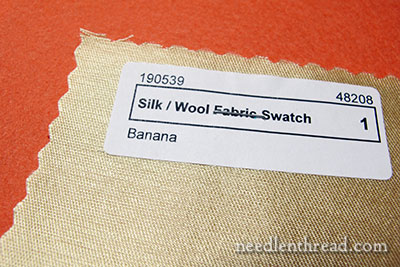
Blends are fabrics that contain more than one type of fiber, and sometimes, they can work for hand embroidery quite well.
Now, I’m not talking about natural / synthetic blends – I generally steer away from those, just like I do full-fledged synthetic fabrics. But natural / natural blends? Well, they’re a different story.
Some natural / natural blends, I don’t like. I’ve yet to find, for example, a linen / cotton blend that I really love, and I think that’s because a linen / cotton blend just can’t measure up to the real deal of good linen.
I’ve found many blends to be rather spongy, compared to the 100% options.
Spongy is my word for fabric that doesn’t hold a taut surface, that boings about, that retains a soft dent where you’re embroidered, when it’s pulled taut in a hoop or frame. Spongy fabric also has a little stretch on the grain, not just on the bias, and on the bias, spongy fabric has a seriously stretchy stretch.
I was on the prowl for silk fabrics that would make a good ground fabric for certain types of embroidery (goldwork, silk work, ecclesiastical embroidery, and the like), when I came across a silk / wool blend and a silk / cotton blend.
These are obviously fabrics used in the fashion world, but my curiosity was piqued. I wondered how they would work as a ground fabric for embroidery, and whether or not they would be spongy.
So I did what every serious fabric prowler does, and I ordered an abundance of swatches. Buying swatches is the only way to truly know a fabric before investing in a larger piece. It’s also the best way to see the real color of a fabric, especially if you are hunting for fabric online.
The nice thing about swatches from a conscientious fabric company is that they are always marked, so you know exactly which fabric you’re playing with. I save swatches in a notebook, with all the relevant order details, so I know where to find the fabric when next I seek it.
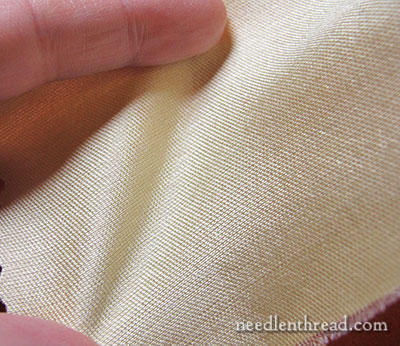
So, I ordered swatches. They came. They were about four inches square. Just enough to play with.
My first impression upon looking at the silk / wool blend was that…wow. It’s a pretty fabric! When I touched it, I said, Wow. It feels nice. And then I wondered how spongy it was.
I stretched it on the bias. It stretched as any fabric does – but it didn’t feel loosely-boingy. It felt a lot like the stretch on a good piece of silk satin.
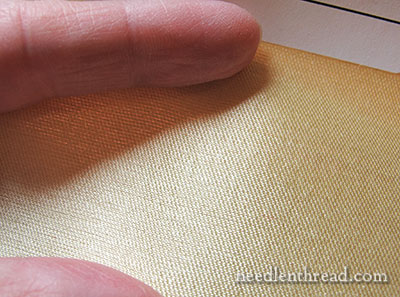
Then, because I had already fallen in love with this particular swatch of “banana” silk / wool blend (it isn’t really what I’d call banana yellow, but it is gorgeous), I whispered a little prayer, I kissed the fabric fervently and pleaded with it, and then I tried stretching it on the grain.
Tight as a tick!
Oh, you happy, lovely fabric! You passed your first test.
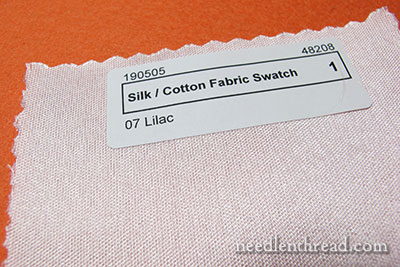
Then, I put a piece of silk / cotton through the same extreme rigors.
It passed, too.
Test 1 was complete. Neither fabric felt spongy when stretched in either direction.
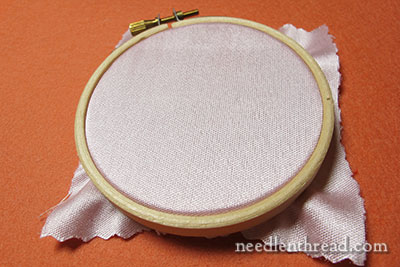
Initially, because the fabric swatches were small, I was going to attach them to a cotton ground and stretch them onto a larger frame to see how they would hold up to framing up.
But then I remembered I had a few of these 3″ teaching hoops, and that they were already bound with twill tape. And they fit just perfectly. So I hooped up the silk / cotton lilac swatch (which is not my idea of lilac – it’s a bit pale and insipid in the pinky sphere of things).
My goal was to see if I could hoop it up to drum taut tension, and how it would perform under drum taut tension. Would it maintain good tension, even if poked and prodded and pulled stitched upon?
Well, it hooped up perfectly, to a nice drum tautness – I could tap away on it forever and revel in its drumminess.
Another good sign.
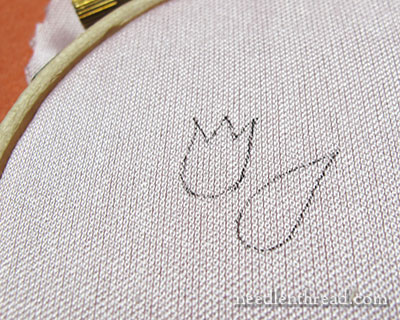
Another test: would a micron pen used to draw a design bleed on this fabric? Nooooooo, it doesn’t. And that is jolly good! For those of you who have used silk satin before, you know that the shiny side of silk satin tends to suck ink into hairy bleed lines. But not this stuff!
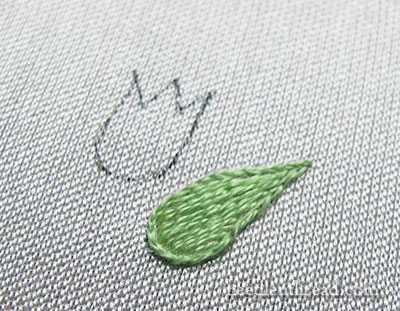
For stitching, I chose Soie d’Alger, which is a soft, spun silk. I wanted to see how the fabric behaved towards this softer thread. Would it eat it up and make it fuzzy, fast?
Another stitch-related test: I wanted to see if the needle would make any visible fissures or separation lines in the weave of the fabric when it passed in and out. Those of you who have embroidered on silk satin or silk dupioni know that this can happen now and then, and it can be distressing if it ends up being noticeable.
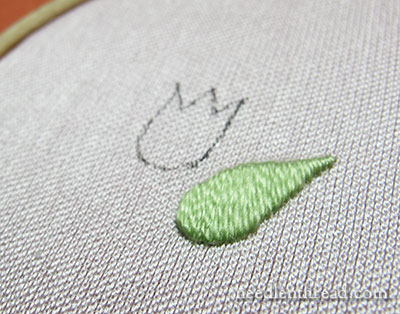
Well, the Soie d’Alger held up just fine, using a standard short piece (about 16″).
And as for fabric fissures? Not a one, not a one! You little champ, you!
You can see in the photos that there is quite a noticeable weave to the fabric on this silk / cotton blend. I found that the weave actually made the stitching a little easier. I found myself using it to gauge stitch length and spacing.
Incidentally, in case you can’t tell from the photos, both the silk / wool and the silk / cotton have a sheen to them (thanks to the silk, and, in the wool blend’s case, somewhat to the wool, too). The silk / wool has more of a sheen than the silk / cotton, but they both have a noticeable, and beautiful, sheen.
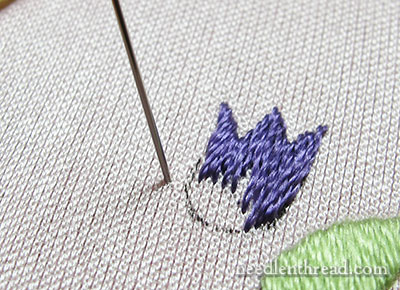
For kicks, I tried Soie de Paris with some long and short stitch. All went well.
Notice where the needle is sticking up from the fabric? The fabric is not the least bit perturbed by it.
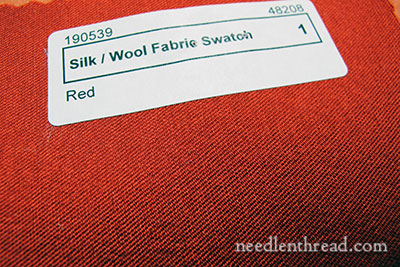
Next up was a silk / wool swatch, this time in red. And oh! What a red! Goldwork, beetle wing embroidery, jewel tones for something exotic and rich? I could see it.
But then, I’m partial to red!
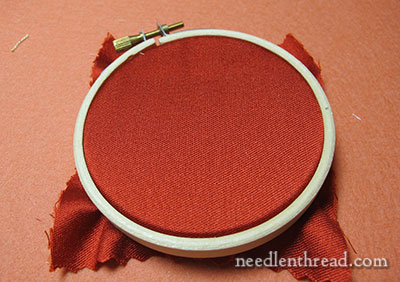
It hooped up beautifully and taut.
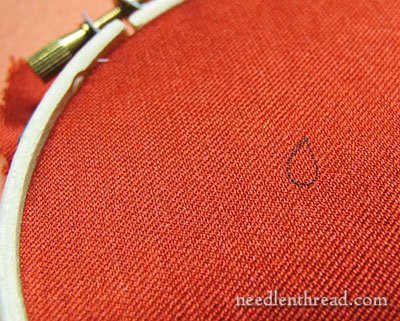
The micron pen did not bleed on the fabric at all.
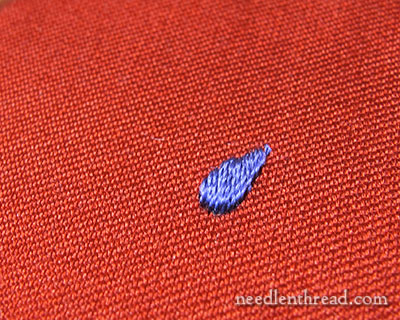
And although my stitching went completely awry, the fabric held up well to stitching – no fissures.
So I’ve added these silk / wool and silk / cotton blends to my swatch book of possible ground fabrics for hand embroidery, and later on, I suspect you’ll see one or the other turn up again here on Needle ‘n Thread, where it will be heartily embellished.
Tips for Selecting Ground Fabrics
Some tips when looking for ground fabrics for hand embroidery:
1. Consider your project and ask yourself what type of fabric will be most appropriate for the project. If you’re doing goldwork, cotton is not really an appropriate choice, for example. Or if you want to embroider a baby blanket, you probably wouldn’t choose linen, and if you’re stitching a fun little kitchen towel that will get used, silk isn’t really an option!
2. Look for 100% natural fibers – flax (linen), 100% silk, 100% cotton, 100% wool. Natural fabrics behave better for hand embroidery.
3. If you come across a blend, check the fiber make-up. Avoid natural / synthetic blends; especially avoid fabrics with even a little bit of lycra in them. Look for natural fibers blended together.
4. Check the weave of the fabric. A close weave (not loose and gauzy) will support embroidery better. Feel the fabric – check the “hand” (how it feels to the hand). Is it nubby and scratchy and dry and brittle? Or smooth and supple and soft? Check the drape, if drape is important in the finished product (for example, are you embroidering a piece of clothing that you expect to be slightly flowy? It needs to have some drape to it.)
5. Determine what cut you can purchase. If you are doing a one-off, small project and you can only order by the whole yard, you might not want to invest in a whole yard. Consider a different fabric. If, however, the fabric is perfect for what you want, find out if you can order it elsewhere in smaller cuts.
6. Order (or ask for) swatches. Test them with everything you plan to do with the ground fabric on the actual project. Do you need to be able to wash it? Check the shrinkage, check the colorfastness, check the rate of wrinkleness. Do you need to mark on it with ink or paint or chalk? Check to see how well these work on the swatch. And finally, stitch on the swatch and see how the fabric and thread work together.
7. Keep a swatch folder. A binder with card stock for the pages, on which you can staple swatches and take notes, works great. Use dividers for fabric types – linen, silk, cotton, wool, blends, etc. This will serve as a handy reference down the road, especially if you want to use the same fabric again, but you can’t remember the details!
8. Buy the best fabric you can afford to buy for your embroidery project. Your ground fabric has more than a little influence over the outcome of your project.
What about you? Do you have any good tips for seeking out ground fabrics for hand embroidery? Feel free to share them below, or to ask questions or add to the conversation!







Mary, where did you find those great fabrics?
These particular swatches came from NY Fashion Center online. If you plan to order a bunch of swatches from them, make sure you look up their swatch club. It’s a one-time $10 fee to join, but all your swatches are then half price, which makes it worth while if you tend to order a lot of swatches. I’m going to do some digging for the fabric, though, to see if I can find other sources, too.
Excellent article. I have some mystery fabrics here at home. I bought them on sale in the embroidery aisle of a fabric store and thought they’d be fine for cross stitch. Nice even weaves. But they feel slippery and soft. Fine for touching but lousy for stitching. I’m guessing they have some synthetic fibers in them. Next time I’ll know better.
Dear mary:
Love this article! Having had disappointing results with my silk duping, I would love to try the silk/wool blend. Could you list your source? i buy most of my material for garment sewing online as it is, and would .ove to know where you sourced your samples. Thank you!
Jan
These particular swatches came from NY Fashion Center fabrics online.
Mary,
Where, oh where, did you get these neat fabrics from?????
These particular swatches came from NY Fashion Center online. If you plan to order a bunch of swatches from them, make sure you look up their swatch club. It’s a one-time $10 fee to join, but all your swatches are then half price, which makes it worth while if you tend to order a lot of swatches.
I plan to look around for the fabric a bit, though, to see if I can find it at a better price. Both of the fabrics are a little pricy, and they have yardage minimums.
Hmmm…maybe we could order the yardage minimums as a group. Just thinking… just thinking…
When you buy the fabric, and have leftovers cause the piece is bigger than the project, how do you store/label the leftovers?
I have lots of fabric, I’ve made clothes and crafty stuff my whole life. Because I made clothes the leftover cotton/poly blends is what went into the crafts. And then there was the yard sale finds.
Now I have a good idea why I had to fight some of my projects to get them to come out decent.
This project is exciting for me. It’s special. A step away from just using scraps. There is a safety built in to just using scraps, if it is messed up I could just pitch it and not be out anything. It’s just scraps. I have done embroidery my whole life and with this project I am taking off the training wheels. This project is not “just”. It’s special. It’s exciting. Before the needle ever touches the fabric it’s special.
Today I am at the tracing stage.
Smiles to you
And thanks
Linda
Hi Mary, Can I ask where you ordered your swatches from? I didn’t see a place in your article. Thanks a bunch.
Colleen in Canada
For these particular swatches, I got them at NY Fashion Center fabrics, online. If you intend to buy swatches from them, look for their swatch club. There’s a one-time $10 fee to join, but if you’re getting a lot of swatches, it is worth it, as the swatches are expensive. In the swatch club, you get the swatches for 50% off.
I’m going to try to source the fabrics from somewhere else, though, because I think this website is somewhat expensive, and they require a minimum yardage. Some fabrics, you can get a yard cut as a minimum, but others, it’s five yards, so it just depends….
Hi Mary,
I have two great sources. D’harma Trading, located in the U.S. They have every kind of silk imaginable and great prices. I stitch on 12 mm habotai silk with 100% quilt cotton backing. I also like to use dupionni silk in cream and black for my botanical studies.
Another source is G&S Dye in Toronto. They have a lovely silk/wool blend fabric that is beautiful to stitch on. It is slightly heavier in weight. I back it also with cotton, as I do with every project I work on. It hides any translucency and makes your embroidery much more durable.
Mary – how did it look when you un-hooped it? Was it stretched out of shape and stayed that way when you pressed it? Or was it still good? Great article; thanks for all the good info!
It was not stretched out of shape at all, but there were slight wrinkles from the hoop, which is typical of any fabric. These ironed out pretty well, but with this type of fabric, I wouldn’t hoop it anyway. I’d use it stretched on a frame.
Thank you so much for a delightful morning read :)! I am a fabricaholic but more for historic costuming (altho many of those leftover scraps end up in the embroidery projects stash)and truly enjoyed your descriptions of these fabric tests. I only used a silk/cotton blend before but now will definitely try the silk/wool, and keep these in mind for stitch projects, not just finishing.
But Silk Velvet; yuk, uhuh, no no no, blaaaak! I’ve had a lot of fun dying it, and even steam embossing it but sewing a whole garment with it. Never. Again. It’s Alive………..
Yes, it’s definitely slippery stuff!! 🙂
Mary, regarding fabrics for embroidery other than linen, I purchased a
Package of 300 thread count Indian 100 % cotton fabric. It suggests using a fusible embroidery stabilizer to the back. Can you tell me if you use a stabilizer when you embroider and if so what type? Thank you.
Hi, Brenda – I never use any kind of fusible stabilizer for hand embroidery. If you need extra support for the embroidery and need to back the ground fabric, use cotton muslin. Make sure both the ground fabric and the backing are lined up on the grain – if either is on the bias even slightly, you’ll end up with a messy finish. I hoop or frame up both fabrics at the same time. ~MC
Thank you Mary for reviewing more fabric resources! For Brenda & anyone else who might like to try a fusible stabilizer, may I recommend Presto Sheer? Usual disclaimers & no relation to the company! Just very glad I was introduced to the product in a class. While cotton muslin is still my favorite support for ground fabric, there have been applications where this fusible is preferable IMHO. It’s easy to sew thru & I’ve been very pleased with the finished items. It is my understanding that it is 100% cotton, pre-shrunk & comes from Germany. It’s available from specialty vendors in the US.
Great article! I’m glad to see that you’ve ordered these from NY Fashion Center Fabrics. I order silk shantung from them and they have great service. I will definitely be on the hunt for silk blends from them.
One of the comments suggested Dharma Trading. I love their silk dupion is really nice to work with and dyes up really beautifully.
Where do you order your swatches from? What company lets you just order swatches?
I love the idea of having a swatch book for reference.
Hi, Mary Jane – from NY Fashion Center fabrics. Additional information can be found in previous comments here on the site…
Hello –
The name “Banana silk” can also be a nicer name for a rayon fiber. Thanks for a lovely and informative site.
Mary, Would you share which companies you purchased samples from?
Hi, Carol – from NY Fashion Center fabrics – you can find additional information in the comments here in the website… MC
Thank you for the information regarding stitching fabric. Although I do mostly cross stitch and just started ‘playing” with other types of stitching – poor quality ground fabric can literally destroy hours of work.
Linen (flax) is wonderful to work on, and to wear, and to maintain – agree, it is my all time favorite fabric!
Dear Mary
Firstly Happy Birthday I hope your having a lovely day.
The silk/wool and silk/cotton blends look really great fabrics I wondered where you purchased them from but after reading the comments I now know. I agree that fabrics made of linen, cotton, silk are the best for embroidery projects. I’m using silk organza material at the moment although it’s nice in Tambour work, however, once you’ve made a hole in the fabric it doesn’t spring back like it does on linen, so I have to be careful where I’m placing the tambour hook in the fabric. Thanks for your detailed advice on using different fabric blends.
Regards Anita Simmance
Thanks, Anita! Yes, organza is notoriously difficult to stitch on, for that very reason. But it’s so beautiful!
Your welcome
Thai Silks in Los Altos, CA is also an excellent source. http://www.thaisilks.com
Mary – I have used a cotton/linen blend called Quaker Linen for several blackwork projects. It has some of the same qualities of linen (slubs, good texture, fairly even-weave). I like it because you can easily see the holes to do the work and it really looks like linen. I used 28 count – don’t know if it comes in other counts.
Great article! And my question was answered below. Did you say you got your samples from the NY Fashion Center online? LOL Thanks many times over.
🙂 make sure, if you are planning to buy lots of swatches from them, that you join their swatch club – the one time fee of $10 is worth it if you’re buying a lot of swatches, which are 50% off if you join. I find the swatches otherwise pretty expensive. I’m hunting around for other sources for the fabric, too.
Thank you for the incredible article. Right now I’m having a fabric nightmare of my own. I want to monogram 8 linen napkins for my sister’s anniversary but I just don’t know what to look for! The ONLY place I found that I trust that the napkins are 100% linen is CrateNBarrel but they look almost tissue thin, I’m beside myself…
Marie,
Thank you very much for this article about the different fabrics we can use. I just bought a fabric blend of organic hemp with silk cream color. Quite heavy weight fabric, gorgeous but I think I’m either too big needles because some points mark the fabric too meadows … or if I still did not know embroidery correctly and I was also wondering if I should double but saw its thickness, I gave up doing it. I am like you Mary, I love beautify and beautiful fabrics make me crack.
Thank you for sharing this information.
Thanks for the great info on how you conduct your testing!
My go-to place for linen is fabrics-store.com, as the quality, pricing and occasional amazing sales seem to fit the bill for me. I have had good luck with http://www.jrbsilks.com/silk-fabric/silk-taffeta-solids for all kinds of silks. I have yet to find a good source for basic woollens – do you?
I’ve never had good luck with fabric.com or fabric-store.com when it comes to linen. I’ve found the linens a bit too irregular and flimsy for most hand embroidery. I don’t use wool too often – just for blanketing once, and I ordered that from Australia. -MC
Aloha Mary,
Love the fabrics. Just a word of caution,ask the company if they keep these fabrics in stock. Sometimes between ordering the sample and waiting to make a decision about what or how much to buy, the fabric can sell out. Experience speaking here, lol.
Having bought silk/cotton blouses, what a treat they are. I would think silk/cotton would be good for shadow work or delicate embroidery.
If I were a baby, I would want a summer sheet set made from this fabric. It is almost weightless.
Did you notice any shrinkage on the silk/wool test swatch when pressing ? Sometimes wool will shrink just from a light steaming.
Regards,
ji
This silk cotton is actually very dense and would not be suitable for shadow work. I didn’t wash them, as they are not fabrics I would use on anything washable – I’d use them for silk and goldwork. The tips at the end of the article clarify that, when testing fabrics, if the finished item is to be washed, it’s best to test washability before using it as a ground fabric.
Thanks for solving a huge problem for me. When I was young, my finished embroidered pieces from kits looked prettier than when I have occasionally tried them in recent years. Now, I see it is likely because the ground fabric in today’s over-the-counter kits are usually a synthetic blend or some cotton blended with a synthetic. Based on today’s article, my kit days are over! I’m no where close to being the embroiderer you and most of your fans are, but I still love stitching when I can find the time.
So please share. Exactly which linen blend fabrics did you test, and where did you get them? Please!
Hi, Brooke – I tested both of the blends mentioned above, and I got the swatches through NY Fashion Center fabrics. -MC
Birthday wishes Mary, many happy returns of the day. I have a beautiful silk/linen blend material I will try following your great hints. Jude
Thanks, Jude!
Yes, happy birthday, Mrs. Corbet!
(sorry I forgot)
Thank you, Mary! Very good info. Outstanding info for vestments and heirloom or dress-up. My orientation is for embroidery on ethnic clothing, doll clothes and my own clothes. Farmhouse Fabrics has some very high-end cotton shirtings, batiste, voile, etc. I recently discovered Mood, and while my computer doesn’t handle their website well, I did find, for example, oodles of gorgeous colors in cotton sateen (with and without stretch!) — if you can think of it, they probably have it! Good prices, too. Anyone visiting San Francisco, Britex of course, but I’d say check out Satin Moon on the 38 bus line also. I wish I’d gotten their pale pink Viyella! What a luxury! Cotton/wool mix. A few joyful flowers on the pocket? . . . Budapest in 1986 was a disappointment to me because the embroidered blouses for the tourist trade were all done beautifully on horrible poly silky. I bought a gorgeous old dress of linen so heavy it would almost make a tent — or sails! It has faded multi-color embroidery and great volume, but is unwearable by an adult, being short from neck to underarm. It’s good for nothing but hanging from the ceiling on a pole! . . . There seems to be a new trend in quilting using voile, many cotton and cotton-silk voiles available. I’m ready for a whole new summer of love.Thank you, Mary!
Hi, Mimi – yes, I’ve ordered cottons from Farmhouse Fabrics, too. They have very nice fabrics, if you’re looking for cotton!
Oh Mary, I really know what you mean about problems when stitching silk satin. I love the fabric however it can sometimes “ladder” and destroys the look of the finished embroidery. Is there a way I can avoid this happening, please?
Hi, Catherine – Some people stitch on the back of it, instead of the front. The “wrong” side doesn’t have the highest sheen, but it seems to take embroidery better for some. You might also make sure that the needles you’re using are small enough, and that they are completely free of any burrs, especially at the tip. A burr on a needle when working with any fabric is not a good thing, but when you’re working with silks, it can wreak havoc. ~MC
Thank you very much, Mary. Must remember to use that emery strawberry (a very useful tool) and those number 12 needles in pretty packets from the Royal School of Needlework.
hola Mary no puedo traducir tu hermosa y util pagina
un abrazo
lidas
Que lastima, Lidas! Hay que aprender poco mas ingles! But they do beautiful bordados in Spain; I lived there and collected patterns and a few luncheon cloths. Mary is “the best”; however she is also subtle. I’m not sure an automatic computer translation would help much. On another website they’re selling “water-soluble” lace for your wedding gown. What they mean is — washable! Is translation pricey? Just wondering what is involved. . .
Hi Mary,
I am right with you on synthetics being icky! I am also a seamstress, and when my children were small in the 80’s it was hard to find 100% cotton at all. Luckily with my grandchildren that has changed. I think the quilting revolution had a lot to do with that. The funny thing is if you look for pre-printed embroidery blocks for quilts you can’t find any that aren’t 50%cotton 50% polyester which any quilter worth her salt would never use. In fact most pre-printed linens are that way. I don’t know about you but I don’t want to sleep or lay my head on anything that isn’t 100% cotton unless it were linen. Have you ever priced linen sheets? They are exorbitant. I do most of my stitching on linen. I do have a good source for a very tightly woven muslin which I make toys from for my grandchildren. At the moment I am making a farm set for my youngest grandson. All of the animals are embroidered front and back and then they will be stuffed with Kapok, a stuffing that was used when I was a child before polyester filling came out. It is harvested from the Kapok tree in the rainforests of South America. Maybe if more people were aware of it and used it the people there would see a cash crop and quit cutting down the rainforests! It is the softest filling you will ever touch.
Back on track, I am also embroidering a barn/case. I also embroider cotton kitchen towels from time to time. I have embroidered on 100% silk with all silk threads and silk ribbon to great success. And I have done wool blankets. You have definitely piqued my interest in the two blends above mainly because I enjoy embroidering on silk but your hands have to be absolutely smooth which sometimes mine aren’t. I have also had your same reaction to cotton/linen blends. I think it’s odd as both of them are so nice to embroider on but put them together and something does happen which is not good. Thank you so much for your article today and the two new leads. By the way most online fabric stores have a remnant button. where I get most of my linen their remnants are marked down like a regular fabric store. I have a medium stockpile of linen in many colors and sizes that I got much cheaper by going this route. Sometimes the remnants can be larger than a yard making a project like napkins or placemats quite affordable and with your embroidery heirloom quality.
this was a wonderful article. Thank you for taking the time to explain everything that you do to test fabric. I am not very experienced in background fabric selection. this was very informative.
I love to sew with wool/silk blends. They’re just luscious – the shine is to die for but they’ve got that indescribable ‘hand’ that only quality wool can impart. I’ve never used it for surface embroidery but it smocks up like a dream. If I ever ended up on an deserted island and had only one fabric I could ever use, ever again, wool (and wool/silk) would be what I would choose! 🙂
can you share the name of the business where you ordered the wool/linen and silk samples?
Sorry Mary, didn’t realize you answered the question a zillion times already – I didn’t know how to delete my post. Kathy
🙂 that’s ok, Kathy!
I’ve just done an altar frontal on a silk/linen blend that is just delightful. It *might* have come from fabric.com (not sure, my Mom acquired it for the project). Something else to keep an eye out for!
Can you expand on what you were looking for when stretching the sample on the bias and grain?
Years ago (50-55!), I did a lot of embroidery on a cloth called Indianhead. Given the era and our financial situation, I’m quite certain this was 100% cotton. Is there a similar cotton available now?
Thank you!
Here’s a an excellent article on the history of Indian Head cotton fabric: http://info.fabrics.net/indian-head-remembered-revisiting-an-american-institution/
Where did you find the silk wool/silk cotton blends? What do you think of the hand dyed fabrics like Lugana and Jobelan?
Hi, Mary jo – I found those particular blends at NY Fashion Center Fabrics, online. I ordered swatches and then I ordered the lengths of the ones I wanted to use, after I saw the swatches. What I like is that they are natural fiber blends. Lugana and Jobelan are not. I prefer working with natural fibers. When it comes to hand-dyed fabrics, you might exercise caution – if you ever have to wash them, the hand dyeing may prove problematic. Also, hand dyed fabrics tend to fade, so be careful not to display finished work where the sun hits it. You might even consider, if you’re framing your work, framing it behind museum quality glass, to help slow down the fading.
How do you attach the cotton backing to your ground fabric for hand embroidery? I am planning to embroider a vestment for my son in seminary
Hi, Sue – I normally just frame both pieces of fabric up at the same time, making sure they are aligned on the grain. Then, once they’re in the frame and tightened, I baste around the outside of the design area (and sometimes through it as well) with a sewing thread, just in case I have to take the piece off the frame for any reason. Here’s an article where I’ve done this: https://needlenthread.wpengine.com/2011/11/stop-shifting-simple-basting.html Hope that helps!
Please tell me where you ordered the silk/wool and silk/cotton fabric. Thanks. Denise
I see you answered this question. Thanks.
I am trying to recover a lampshade frame with hand embroidery. I wanted to use silk, but cannot find enough information for the use on lampshades. It should stretch for ease of covering the metal frame. It will be going on a vintage floor lamp. Also, what fabric would be best for the inner lining?
I would appreciate your expertise in this manner.
Thank you,
Margaret Vicente
Hello Mary,
Thank you for the infor about ground fabric for embroidery. I have done embroidery on silk charmeuse. It came out beautifully. Now I am making dance flags and I want to embroider some verses, habutoi or China silk is best for dance flags. But thinking maybe habutoi silk is too thin to embroider and might change the weight and the flow. Maybe silk charmeuse is better? What do you think?
Thank you
Tsegi
Hi, Tsegi – I’m afraid I can’t really advise on that, because I’m not exactly sure of the performance of either silk in the situation you’re talking about, especially with embroidery on them – and it also depends how much and what kind of embroidery. I think both fabrics will be difficult to stitch on, as they’re relatively fine and slippery. I think your best bet is to do a test run with each fabric. It doesn’t have to be full sized, but I’d buy a smallish length of both and practice, to see what works better for you. I know it might seem like a waste of money, but better to invest a little time and money on the front end, then to put even more time and money into something that might not work out the way you want it to.
What were these fabrics? I am interested in ordering some but can only find cotton and linen ground fabric
I understand that they are silk/cotton, silk/wool blends, but I am wondering who the manufacturer is. I cannot seem to access the NY Fashion Center website, but was thinking I might be able to order elsewhere. I want to embroider a handkerchief that will bind a bride and groom’s hands together during their wedding ceremony.
Wow. I loved your fabric analysis! I wish I had read it sooner! Better late than never. I am definitely starting a binder with fabric samples. Thank you!!!